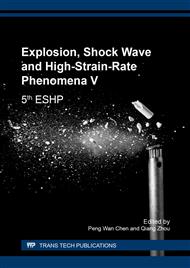[1]
M. Acarer, Electrical, Corrosion and Mechanical properties of aluminium-copper joints produced by explosive welding, J. Mater. Engg. Perform. 21 (11) (2012) 2375-2379.
DOI: 10.1007/s11665-012-0203-6
Google Scholar
[2]
B. Gulenc, Y. Kaya, A. Durgutlu, I.T. Gulenc, M. S. Yildirim, N. Kahraman, Production of wire reinforced composite materials through explosive welding, Arch Civ. Mech. Eng. 16 (1) (2016) 1-8.
DOI: 10.1016/j.acme.2015.09.006
Google Scholar
[3]
P. Tamilchelvan, K. Raghukandan, S. Saravanan, Optimization of process parameters in explosive cladding of titanium/stainless steel 304L plates, Int. J. Mater. Res. 104 (12) (2013) 1205-1211.
DOI: 10.3139/146.110977
Google Scholar
[4]
S. Saravanan, K. Raghukandan, Diffusion kinetics in explosive cladding of dissimilar alloys as described through Miedma model, Arch. Metall. Mater. 59 (4), 2014, 1615-1618.
DOI: 10.2478/amm-2014-0274
Google Scholar
[5]
A. Durgutlu, B. Gulenc, F. Findik, Examination of copper/stainless steel joints formed by explosive welding, Mater. Des. 26 (6) (2005) 497-507.
DOI: 10.1016/j.matdes.2004.07.021
Google Scholar
[6]
S. Saravanan, K. Raghukandan, Influence of interlayer in explosive cladding of dissimilar metals, Mater. Manuf. Proces. 28 (5) (2013) 589-594.
DOI: 10.1080/10426914.2012.736665
Google Scholar
[7]
P. Manikandan, K. Hokamoto, M. Fujita, K. Raghukandan, R. Tomashige, Control of energetic conditions by employing interlayer of different thickness for explosive welding of titanium/ 304 stainless steel, J. Mater. Proces. Tech., 195 (1-3) (2008).
DOI: 10.1016/j.jmatprotec.2007.05.002
Google Scholar
[8]
S. Saravanan, K. Raghukandan, Thermal Kinetics in explosive cladding of dissimilar metals, Sci. Tech. Weld. Joi. 17 (2) (2012) 99-103.
DOI: 10.1179/1362171811y.0000000080
Google Scholar
[9]
P. Tamilchelvan, K. Raghukandan, S. Saravanan, Kinetic energy dissipation in Ti-SS explosive cladding with multi loading ratios, IJST-T Mech. Eng. 38(M1) (2014) 91-96.
Google Scholar
[10]
S. Saravanan, K, Raghukandan and K. Hokamoto, Improved microstructure and mechanical properties of dissimilar explosive cladding by means of interlayer technique, Arch. Civ. Mech. Eng. 16 (4) (2016) 563-568.
DOI: 10.1016/j.acme.2016.03.009
Google Scholar
[11]
P. Mastanaiah, G. Madhusudhan Reddy, K. Sathya Prasad, C.V.S. Murthy, An investigation on microstructures and mechanical properties of explosive cladded C 103 niobium alloy over C263 nimonic alloy, J. Mater. Proces. Technol. 214 (11) (2014).
DOI: 10.1016/j.jmatprotec.2014.04.025
Google Scholar
[12]
S. Saravanan, K. Raghukandan, N. Sivagurumanikandan, Pulsed Nd: YAG laser welding and subsequent post-weld heat treatment on super duplex stainless steel, J. Manuf. Process. 25 (2017) 284-289.
DOI: 10.1016/j.jmapro.2016.12.015
Google Scholar


